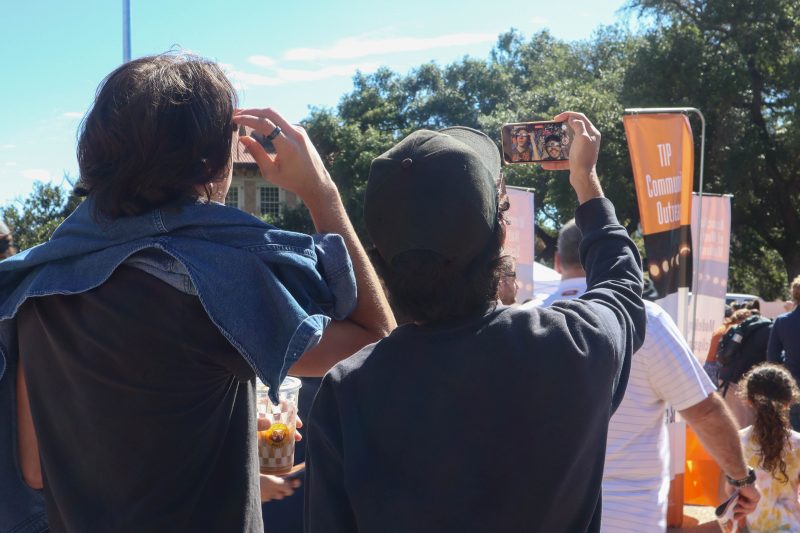Understanding the Incredibly Rare Total Solar Eclipse in Central Texas
By Isabella McGovern
Reporting Texas

University of Texas students and others view the annular eclipse last October on the university South Mall during a watch party. A total eclipse will occur Monday, just six months after the partial eclipse. Michelle Lavergne/reporting Texas
Life was far different for Central Texas residents in 1878. Streets were not paved, homes lacked electricity and fewer than 11,000 people lived in Austin, compared with almost 1 million today.
It was also the last time a total solar eclipse covered Central Texas in darkness. The next one comes Monday, April 8.

Anita Cochran
With excitement over the eclipse reaching a fever pitch, Reporting Texas asked Anita Cochran, a senior research scientist at the University of Texas at Austin and assistant director of the McDonald Observatory in Fort Davis to share her insight into this once-in-a-lifetime event. (Excerpts edited for brevity and clarity.)
What is a total solar eclipse?
A total solar eclipse occurs when the Earth, moon and sun line up, and the moon will completely block the sun.
You have to have the moon come around and be between the sun and the earth, but also that tilt has to be right so that the moon is actually blocking the sun, and that just doesn’t happen every time.
This is the first time in 146 years that a total solar eclipse is going to happen in Central Texas. The next time a total solar eclipse will be visible in the United States will be in 2044, but in Central Texas, it won’t be for about another 350 years.
How long will the eclipse last?
Depending on where you are along the total solar eclipse path, you may be able to see the eclipse covering the sun for a little over four minutes.
If you’re in Austin, it’s going to be about a minute and a half. But if you’re like Fredericksburg, it will be a little over four minutes, so it’s very much going to depend on where you are along the path.
How should we view the eclipse?
Before the event, it is important to wear eclipse glasses so that your eyes’ retinas don’t get damaged. You have to have the glasses when you’re looking at the sun, except during totality when you don’t need the glasses.
During the eclipse, you can take off your glasses for a short period. Viewers will be able to see things like the corona of the sun. The corona is the stuff that looks very hairy coming off the edges of the sun that you wouldn’t be able to see with those glasses. It’s perfectly safe because the moon is blocking the sun’s light. As soon as the moon starts moving off and some of the solar light comes back out, then you must put the solar glasses back on.
How is this different from the eclipse in October 2023?
Last year’s eclipse, Oct. 14, 2023, was an annular solar eclipse. During this kind of event, the moon is between the sun and Earth, but is further from Earth so it appears smaller and doesn’t completely cover the sun. Those happen two to five times a year.
A lot of times it’s either on a very narrow path over the ocean or over someplace else that’s not anywhere near North America.
What unusual things are not being reported about the eclipse?
In addition to looking at the sun, we should look around and listen to the birds and the insects during the eclipse. Birds and the insects are going to get very confused, and so it’s part of what’s fun about the eclipse is just to see the changes.
Since the moon will be blocking the sun, the temperature will also cool.
What other interesting celestial events will happen during the total solar eclipse?
Several planets will be visible during the time of the total solar eclipse, depending on the weather and how dark it will get.
You should be able to probably see Jupiter up to the left of the eclipse, and Venus to the right. If it gets much darker than that, you might see Saturn and Mars off again to the right a little bit further than Venus.
There have been predictions that Comet 12P will also be in view during the total solar eclipse, but it’s very unlikely.
Comet outbursts last a few days making the chances of seeing comets possible, but astronomers cannot predict them. If it has an outburst during the eclipse, it will be to the left of Jupiter. If it’s the magnitude it’s supposed to be, you won’t see it. It’s going to be just a tad too faint.
Where will you be viewing the eclipse?
I am going to be where it is four minutes. We will be going to one of the wineries in Hye, Texas. Hye is on Highway 290 between Johnson City and the LBJ Ranch.